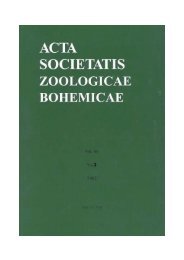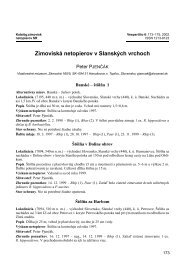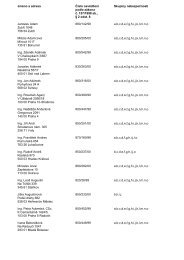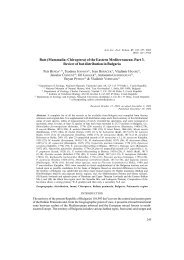Create successful ePaper yourself
Turn your PDF publications into a flip-book with our unique Google optimized e-Paper software.
Arthropods of Burgess Shale type from the Middle Cambrian of Bohemia (Czech Republic)T. magna Yuan et Zhao, 1999, Lower or Middle Cambr.,China (Guizhou);T. manchuriensis Resser et Endo in Resser, 1930, MiddleCambr., China (Manchuria);T. nodosa Resser, 1930, Lower Cambr., British Columbia;T.? parva (Walcott, 1912), Middle Cambr., Burgess Shale;T. polleni Resser, 1930, Lower Cambr., British Columbia;T. praemorsa Resser, 1930, Middle Cambr., Burgess Shale;T. sinensis P’an, 1957, Lower Cambr., South China (Yunnan).T. spinosa Resser, 1930, from the Lower Cambrian ofBritish Columbia is based on insufficient material. T. nitidaResser et Howell, 1938, and T. vermontensis Resser et Howell,1938, from the Lower Cambrian of eastern North America(Appalachians), are poorly known as commented byGlaessner (1979). T.? parva can be regarded as a juvenileontogenic stage of Tuzoia as reported by Briggs (1977).Probable of separate generic position are Tuzoia? dunbariResser, 1930, from the Lower Cambrian of Pennsylvania(marked by extremely developed spines, comp.Resser 1930, Resser and Howell 1938) and Tuzoia? peterseniRobison et Richards, 1981, from the Middle Cambrianof Utah, with a very long posterodorsal spine (lateralridge and sculpture are unknown).Stratigraphic range: late Lower up to late MiddleCambrian.Geographic distribution: North America(western and eastern parts), China, Australia, CentralEurope (Barrandian area, here reported).Tuzoia sp.Pl. I, figs A-D; pl. II, figs A-H; text-figs 1–4Material:6 incomplete carapace valves showing diagnosticfeatures of Tuzoia, other 8 carapace fragments withcharacteristic reticulate sculpture and few other characters.Description. The most completely preserved specimen(MP-SO1748, fig. 1) represents the right carapacevalve with almost complete dorsal margin (length 120mm), broken anterodorsal horn, well traceable lateralridge and incomplete ventral part of the valve. The raisedlongitudinal ridge (preserved length 139 mm) shows asharp crest-like apex for most part of its course. Posterodorsaltermination is protruded into a short and broadhorn-like projection, not prolonged into a spine. Anteriorand ventral margins are broken off; posterior margin formsa gently posterior-bent arc. The characteristic sculptureconsists of marked reticulation of the whole surface. Individualreticulae are of polygonal, most commonly pentagonaland hexagonal outline, obvious diameter 4–6 mm(maximum 7 mm). Reticulae gradually diminish towardsthe margins of the valve and a still more pronounced diminishingof reticulae is marked close to the lateral ridgeand on its surface (observable up to the distance of 4–5 mmfrom the apex of the carina in dorsal and ventral direction).Apart from wrinkles caused by compaction, unsharp, longitudinallyprojected depressions, interpreted as probabletraces of scavengers, radiate from the lateral ridge in dorsal,posterodorsal and posteroventral directions.CBFig. 2. Tuzoia sp. from the Jince Formation, Jince area. A – incompleteright carapace valve VK41, Vinice; B – fragmentary right carapace valve,L36483, counterpart, Vinice; C – fragment of the ventral doublure showingthe external transition into the reticulate sculpture, SZ169; D – incompleteright carapace valve with partly preserved lateral ridge,posteroventral spines and exposed doublure, VK40, Vinice. Scale A, B,D × 0,5, C × 2. Comment to all drawings: dotted lines indicate secondarydamages of the specimens (broken limits etc.).The other two more completely preserved specimens(VK40 – fig. 2D, pl. I, figs A-C, VK41 – fig. 2A, pl. II, figsA-D) show at least partly preserved subelliptical outline ofcarapace valves. A moderately developed anterior hornprojection and the straight dorsal margin is shown inVK41, the lateral ridge with sharp apex and markedlysmaller and densely packed reticulae, and two spines (8.2and 3.1 mm long) partly preserved on the posteroventralmargin can be observed in VK40. The typical reticulatesculpture, consisting of reticulae of polygonal, markedlyFig. 3. Tuzoia sp., reconstruction of the left carapace valve from the JinceFormation, presumed length 110–180 mm.ADA169








